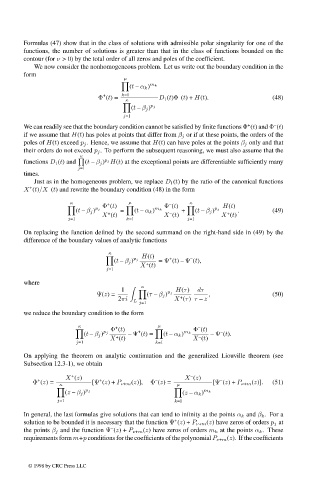Page 636 - Handbook Of Integral Equations
P. 636
Formulas (47) show that in the class of solutions with admissible polar singularity for one of the
functions, the number of solutions is greater than that in the class of functions bounded on the
contour (for ν > 0) by the total order of all zeros and poles of the coefficient.
We now consider the nonhomogeneous problem. Let us write out the boundary condition in the
form
µ
(t – α k ) m k
–
+
Φ (t)= k=1 D 1 (t)Φ (t)+ H(t). (48)
κ
(t – β j ) p j
j=1
+
–
We can readily see that the boundary condition cannot be satisfied by finite functions Φ (t) and Φ (t)
if we assume that H(t) has poles at points that differ from β j or if at these points, the orders of the
poles of H(t) exceed p j . Hence, we assume that H(t) can have poles at the points β j only and that
their orders do not exceed p j . To perform the subsequent reasoning, we must also assume that the
functions D 1 (t) and κ (t – β j ) H(t) at the exceptional points are differentiable sufficiently many
p j
j=1
times.
Just as in the homogeneous problem, we replace D 1 (t) by the ratio of the canonical functions
–
+
X (t)/X (t) and rewrite the boundary condition (48) in the form
κ + µ – κ
Φ (t) Φ (t) H(t)
(t – β j ) p j = (t – α k ) m k + (t – β j ) p j . (49)
+
+
–
X (t) X (t) X (t)
j=1 k=1 j=1
On replacing the function defined by the second summand on the right-hand side in (49) by the
difference of the boundary values of analytic functions
κ
H(t) + –
(t – β j ) p j = Ψ (t) – Ψ (t),
+
X (t)
j=1
where
κ
1 H(τ) dτ
Ψ(z)= (τ – β j ) p j , (50)
+
2πi L X (τ) τ – z
j=1
we reduce the boundary condition to the form
κ + µ –
Φ (t) + Φ (t) –
(t – β j ) p j – Ψ (t)= (t – α k ) m k – Ψ (t).
–
+
X (t) X (t)
j=1 k=1
On applying the theorem on analytic continuation and the generalized Liouville theorem (see
Subsection 12.3-1), we obtain
–
+
X (z) + – X (z) –
+
Φ (z)= [Ψ (z)+ P ν+m (z)], Φ (z)= [Ψ (z)+ P ν+m (z)]. (51)
κ µ
(z – β j ) p j (z – α k ) m k
j=1 k=1
In general, the last formulas give solutions that can tend to infinity at the points α k and β k . For a
+
solution to be bounded it is necessary that the function Ψ (z)+ P ν+m (z) have zeros of orders p j at
–
the points β j and the function Ψ (z)+ P ν+m (z) have zeros of orders m k at the points α k . These
requirements form m+p conditions for the coefficients of the polynomial P ν+m (z). If the coefficients
© 1998 by CRC Press LLC
© 1998 by CRC Press LLC
Page 619

